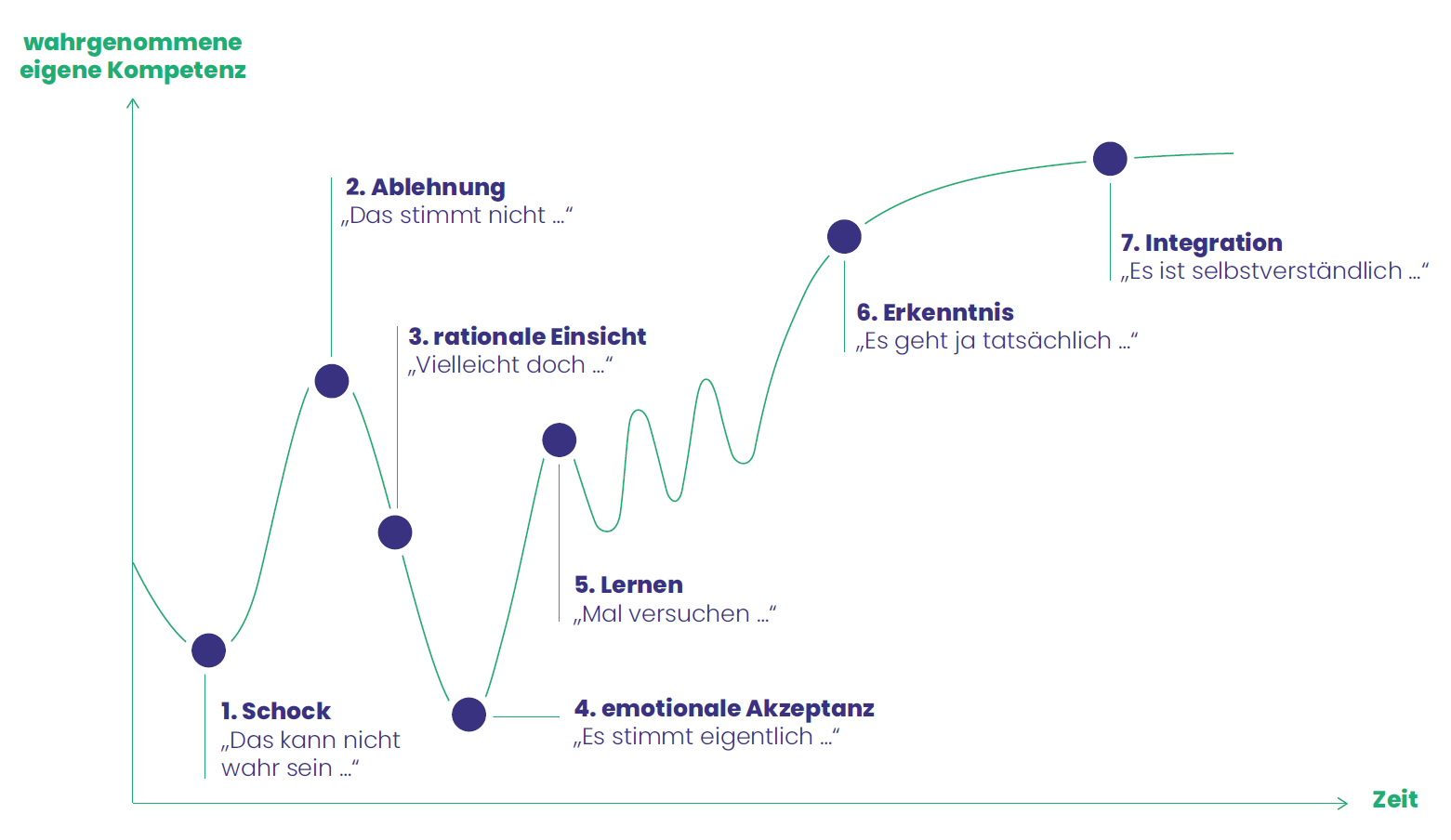
Beyond the hype: Integrating ChatGPT and co. into university teaching
The discussion about the use of ChatGPT in higher education continues to be characterized by emotional reactions such as shock (impressive/frightening) and rejection. It is clear that AI-based (chat) language models will change learning and teaching. How can the hype be shaped in the sense of a change process towards a curious, open attitude via a learning process towards a sustainable, systemic integration into university teaching? In her article, Dana-Kristin Mah argues for more agility and the development of AI skills in university teaching.
How will ChatGPT change learning and teaching? Many higher education institutions and lecturers are currently unsure about the extent to which AI-based language models such as ChatGPT will influence the prevailing learning, teaching and examination culture (e.g. academic writing). Universities and lecturers are responding very differently: some are educating, discussing (e.g. in digital information sessions, handouts, guidelines, blog posts) and advocating a thoughtful and judicious use of ChatGPT. Others are responding with calls for severe restrictions or even bans, and announcing a return to pen-and-paper exams.
Such resistance is not atypical when change is imminent. Change management is the planned management of change processes from an initial state to a target state. Systematic change management for the use of new learning technologies has received little attention (Euler & Seufert, 2007; Ifenthaler, 2020). Systematic change management should be implemented in order to realize a meaningful and sustainable systemic integration of new learning technologies into university teaching and digital transformation (Educase, 2007).
In light of the sometimes highly emotional discussion about the use of ChatGPT in higher education, this article aims to provide a meta-level view to bring more understanding and objectivity to the current debate.
In the following, the seven emotional reactions to (abrupt) change according to Streich (1997) are presented and related to the use of language models such as ChatGPT in university teaching. The focus of this first classification is the perspective of the university lecturer.
Figure 1: Streich's (1997) Seven Phases of Change
1. Shock and surprise:
In November 2022, the ChatGPT language model was released by OpenAI. Within a very short time, the AI-based language model attracted enormous media attention - in the broad social discourse as well as among universities, professors and students. Application examples are shared and discussed daily on social media. The results - especially the linguistic formulations - are fascinating. The content errors and biases of the data sources are (for the time being) little considered by many, even though they form the basis of the answers. Details of the data sources used are not published, it is only known that ChatGPT will be trained on about 45 TB of text by 2021 (e.g. Common Crawl, Reddit, books, Wikipedia).
2. Reluctance & Resistance:
Some higher education institutions react quickly - and ban the use of ChatGPT. They focus on negative aspects such as cheating and plagiarism. Few universities and lecturers react in the opposite way: they provide information, outline application scenarios, explain the new possibilities and formulate framework conditions for use (e.g. rules for tools). Despite some committed pioneers and the ongoing intensive debate, the overall mood for the use of ChatGPT and similar tools in university teaching still seems to be cautious in the spring of 2023.
3. Rational Insight:
At this stage, it is recognized that change can no longer be averted. AI-based tools such as ChatGPT language model are just the beginning. Other language models, such as Google's Bard, follow and are continuously optimized. Only a few German universities and professors seem to have reached this stage. Fast and agile action is advisable in order to proactively shape and influence the process. This applies, for example, to the use and (further) development of AI-based tools, preferably as (free) open source products (e.g. language models OPT, BLOOM).
4. Emotional Acceptance:
This phase marks the turning point in the change process (hopefully soon): The model assumes that the majority of universities/teachers are now open to the new. At this stage, it is particularly important to allow for the mourning of "old habits" and at the same time to provide positive reinforcement: We are ready for the demands of the future. It is possible that there is now a discrepancy between universities/lecturers and students: While students have largely been using AI-based tools such as ChatGPT for a long time, universities are only now beginning to adopt standardized approaches to integrating them into university teaching.
5. Learning:
Universities and university teachers are interested in the new possibilities of using ChatGPT and Co. in the university classroom. They are experimenting with AI-tools: How do AI-based language models work? How can I integrate them into my teaching? What are concrete application scenarios? Are there differences between departments? Questions are also likely to arise on the basis of the use scenarios identified by students.
Smaller and larger learning formats on the topic are particularly helpful: low-threshold introductions in the form of literature such as handouts and blog posts (e.g. the annotated link collection of the Hochschulforum Digitalisierung (HFD), overviews of ChatGPT in the university context from the University of Hamburg and the special report "AI and Education" from University World News) or (learning/explanatory) videos (e.g. the AI Campus video series).
The AI Campus offers free digital learning opportunities on chatbots and spreech assistants. We are also currently developing a new online course specifically for university teachers, but also for students and other interested parties. The online course is designed to enable students to creatively test and critically question the possibilities of using such systems. We look forward to publishing it on the AI Campus in spring 2023.
For teachers and students, the critical thinking aspect of using AI-based tools will be particularly important. Now is the time to act.
6. Recognition:
By actively engaging with AI-based tools (e.g. learning, trying, discussing), the new possibilities will be perceived positively. Universities and professors are encouraged that language models like ChatGPT can actually be integrated into teaching and learning in a meaningful way. Higher education institutions, university teachers and students are expanding their AI skills. The change will gradually become part of everyday teaching. The prerequisite for this is that teachers and students learn together.
7. Integration:
Target state: ChatGPT and Co. have become the new reality in university teaching! Teachers and students use AI-based tools in a reflective and natural way in their classes.
And now?
ChatGPT and the like will continue to receive a lot of attention. For several years now, research on AI in higher education has been continuously intensified (e.g. through funding lines such as Digital Higher Education, AI in Higher Education, and Strengthening Universities through Digitalization). After the initial hype around ChatGPT, it seems useful to think systematically about how AI-based language models and other AI-based tools (e.g. learning analytics) can be integrated into university teaching in a forward-looking way.
Change processes often go through the seven phases outlined above - although there are undoubtedly exceptions! Many universities and lecturers have responded with openness, curiosity and proactivity, and have spoken out in favor of using ChatGPT in teaching. Within a short time, handouts with application examples, link collections on the topic, and guidelines have been created.
Dialogue, adequate support and skill development are particularly important for successful change processes. As in the case of the Covid-19 pandemic, a rapid and constructive response by universities is essential - and German higher education institutions and university teachers have already shown that they can react quickly when necessary (Winde et al., 2020). The extent to which the short-term shift to online teaching is systemic and sustainable is currently being investigated (Berghoff et al., 2021; Lübcke et al., 2022). The German Council of Science and Humanities recommends that universities continue to offer digital learning formats (Wissenschaftsrat, 2022).
The current discussion about ChatGPT has great potential for rethinking the skills needed to learn and teach. From shock to learning and sustainable change.
Literature
Berghoff, S., Horstmann, N., Hüsch, M., & Müller, K. (2021). Studium und Lehre in Zeiten der Corona-Pandemie. Die Sicht von Studierenden und Lehrenden. https://www.che.de/download/studium-lehre-corona/?wpdmdl=16864&refresh=6058894fcf3aa1616415055
Educase. (2007). 7 Things You Should Know About Digital Transformation. EDUCASE Learning Initiative. https://library.educause.edu/resources/2018/10/7-things-you-should-know-about-digital-transformation
Ifenthaler, D. (2020). Change Management for Learning Analytics (N. Pinkwart & S. Liu (eds.); pp. 261–272). Springer Nature Switzerland AG.
Lübcke, M., Bosse, E., Book, A., & Wannemacher, K. (2022). Zukunftskonzepte in Sicht? Auswirkungen der Corona-Pandemie auf die strategische Hochschulentwicklung (No. 63). https://hochschulforumdigitalisierung.de/sites/default/files/dateien/HFD_AP_63_Zukunftskonzepte_in_Sicht_Corona_HIS-HE.pdf
Streich, R. (1997). Veränderungsmangement. In R. Streich, M. Reiß, L. Rosenstiel, & A. Lanz (Eds.), Change-Management: Programme, Projekte und Prozesse (pp. 237–254). Schäffer-Poeschel Verlag.
Winde, M., Werner, S. D., Gumbmann, B., & Hieronimus, S. (2020). Hochschulen, Corona und jetzt? https://www.stifterverband.org/download/file/fid/9313
Wissenschaftsrat. (2022). Empfehlungen zur Digitalisierung in Lehre und Studium. https://doi.org/10.57674/sg3e-wm53






